Selling flats at amount lesser than stamp duty justified as flats had no parking space & electricity connection: ITAT
- News|Blog|Income Tax|
- 2 Min Read
- By Taxmann
- |
- Last Updated on 23 November, 2021

Case Details: Peerless General Finance & Investment Company Ltd. v. DCIT - [2021] 132 taxmann.com 80 (Kolkata - Trib.)
Judiciary and Counsel Details
-
- P.M. Jagtap Vice-President and A.T. Varkey, Judicial Member
- S.K. Tulsian, Adv., Ms. Riya Somani, C.A. and Ms. Lata Goyal, C.A. for the Appellant.
- Sanjay Rai, CIT for the Respondent.
Facts of the Case
Assessee-company sold four flats and offered capital gains of certain amount on same. Assessee computed capital gain lower than stamp duty valuation (SDV) of said flats for reason that said flats did not have a car parking space, and there was also no scope of getting a high voltage electric connection.
Assessing Officer (AO) accepted the same and passed an assessment order. The Pr. Commissioner invoked revision jurisdiction on the ground that impugned order of AO accepting capital gain offered by assessee at lesser amount than SDV of flats was erroneous and prejudicial to revenue. Assessee filed appeal against revisional order before the Kolkata Tribunal.
ITAT Held
The Tribunal has held that as evident from the submission made by the assessee before the AO, the actual sale consideration adopted, which was lower than the stamp duty valuation, was duly explained by the assessee, and the same was also supported by a valuation report of the registered valuer.
It was also relevant to note here that the assessee also made a specific request to the AO to refer the matter relating to the valuation of the property to DVO in terms of section 50C(2) if the lower sale consideration actually received by the assessee than the stamp duty value as justified by it was not acceptable. No such reference, however, was made by the AO.
Thus, it could be held that the explanation offered by the assessee in the matter was found acceptable by the AO, and on appreciation thereof, a well-considered view was taken by the AO. Accordingly, the impugned order passed by the ld. Pr. CIT revising the order of the AO on this issue was not sustainable.
List of Cases Referred to
-
- CIT v. R.K. Construction Co. [2008] 175 Texman 165/[2009] 313 ITR 65 (Guj.) (para.13)
- Dy. CIT v. Peerless General Finance & Investment Co. Ltd. [IT Appeal No. 1470 (Kol.) of 2019, dated 5-12-2019] (para 18).
Disclaimer: The content/information published on the website is only for general information of the user and shall not be construed as legal advice. While the Taxmann has exercised reasonable efforts to ensure the veracity of information/content published, Taxmann shall be under no liability in any manner whatsoever for incorrect information, if any.

Taxmann Publications has a dedicated in-house Research & Editorial Team. This team consists of a team of Chartered Accountants, Company Secretaries, and Lawyers. This team works under the guidance and supervision of editor-in-chief Mr Rakesh Bhargava.
The Research and Editorial Team is responsible for developing reliable and accurate content for the readers. The team follows the six-sigma approach to achieve the benchmark of zero error in its publications and research platforms. The team ensures that the following publication guidelines are thoroughly followed while developing the content:
- The statutory material is obtained only from the authorized and reliable sources
- All the latest developments in the judicial and legislative fields are covered
- Prepare the analytical write-ups on current, controversial, and important issues to help the readers to understand the concept and its implications
- Every content published by Taxmann is complete, accurate and lucid
- All evidence-based statements are supported with proper reference to Section, Circular No., Notification No. or citations
- The golden rules of grammar, style and consistency are thoroughly followed
- Font and size that’s easy to read and remain consistent across all imprint and digital publications are applied




